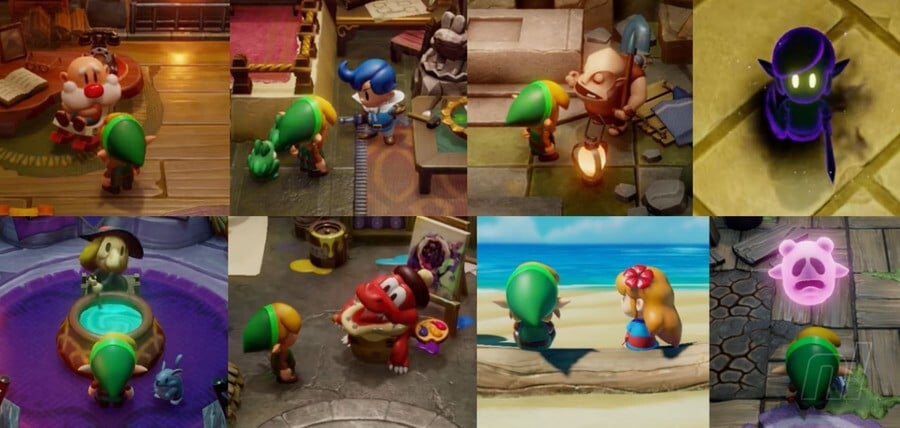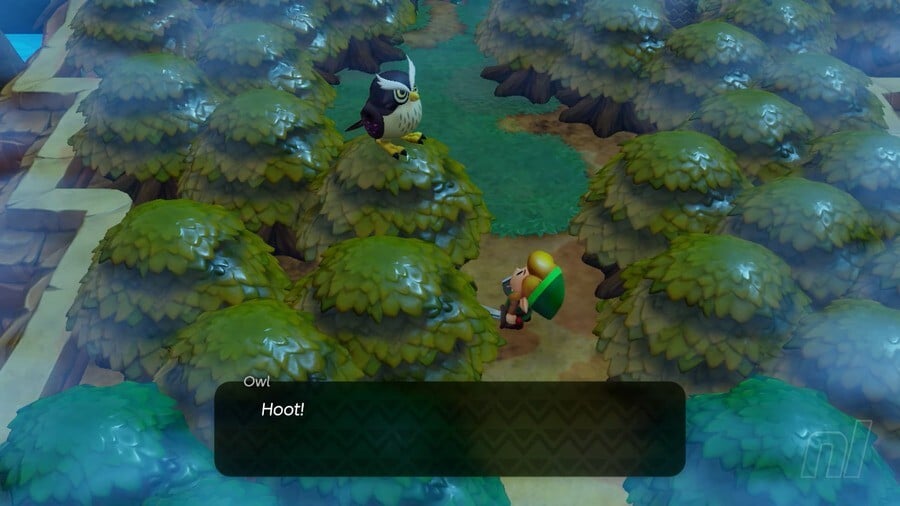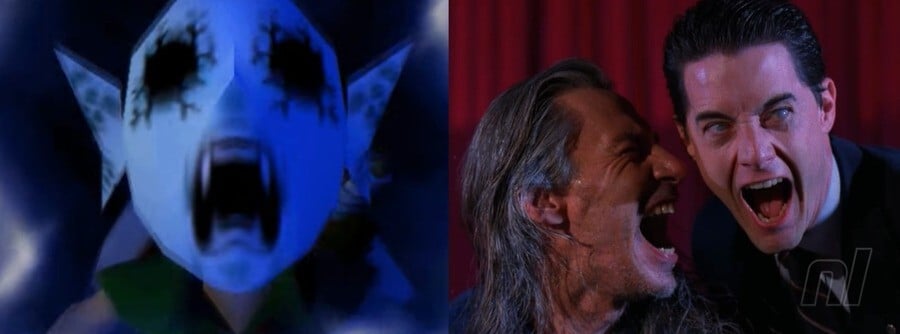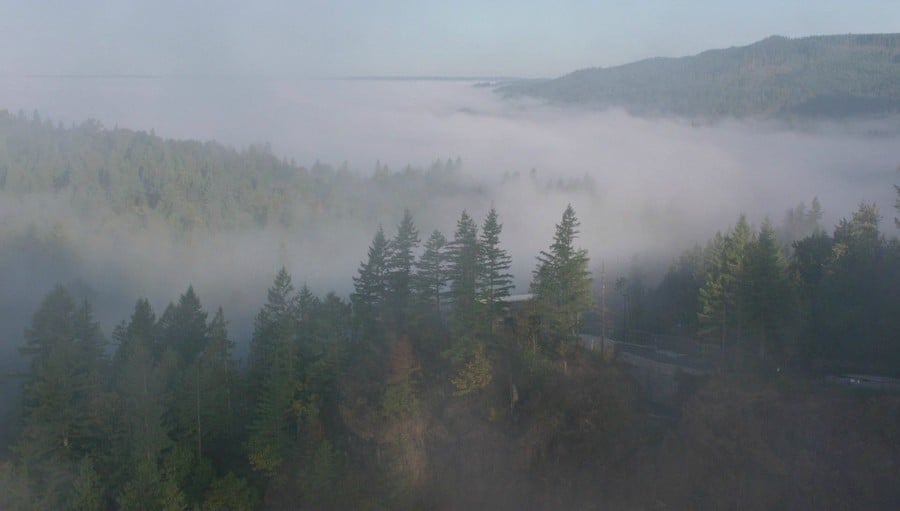
As many of you will have been reminded by playing the recently released remake on Switch, The Legend of Zelda: Link’s Awakening is a surreal little adventure with an odd cast of characters which give Koholint Island a very specific feel. The first portable entry in the celebrated series, this diminutive adventure would go on to influence every Zelda game to come with its otherworldly, dreamlike sense of place and motley crew of oddballs. The developers have noted the conscious influence of David Lynch on the 1993 Game Boy original, so it follows that the writer/director/artist has left a lasting impression on the series as a whole.
In an Iwata Asks interview on the topic of The Legend of Zelda: Spirit Tracks, director Takashi Tezuka was reminded of his desire to build a world of characters inspired by Twin Peaks when he set about creating the original Link’s Awakening in the early '90s. Broadcast in Japan as development began, David Lynch and Mark Frost's hugely influential and bizarre series was as popular there as it was in the West and Tezuka was keen to infuse some of its idyllic small-town flavour and surrealism into his diminutive Game Boy title.
We’re approaching an incredible twenty games in the mainline series now and we’ve grown accustomed to the quirky and oftentimes sinister bit players that give Hyrule a very unique texture in the canon of video game kingdoms. Odd characters have been a feature from the beginning of the series (Zelda II, for example, had plenty of enigmatic, unusual folk residing in its villages), but it wasn’t until the fourth entry in the series that the developers consciously added what Tezuka called ‘suspicious types’:
At the time, Twin Peaks was rather popular. The drama was all about a small number of characters in a small town... So when it came to The Legend of Zelda: Link's Awakening, I wanted to make something that, while it would be small enough in scope to easily understand, it would have deep and distinctive characteristics.
For anybody not familiar with Twin Peaks, the TV show premiered in 1990 and could legitimately be described a dozen different ways, but let’s start with surreal murder-mystery serial. That reductive label, though, hardly does it justice; the show is a synthesis of practically every genre imaginable and defies easy categorisation. Part-supernatural procedural that inspired things like The X-Files, it's also melodramatic soap opera, surrealist comedy, psychological horror, philosophical farce, feel-good nostalgia trip - in fact, it might be quicker to say what it isn't. It's not a musical... although music is utterly integral, and characters aren't beyond breaking into song.

Okay, scrap that - there's an argument for it being part-musical, too. However, despite being of no fixed genre, it had a single question which punctured the confusion and hooked a huge mainstream audience: Who killed Laura Palmer? Lynch takes the viewer on a journey between picture-postcard Douglas fir trees and nightmarish horrors in suburban houses; from the mundanity of diners and high schools to surreal red-curtained waiting rooms with zig-zag flooring populated by maniacal doppelgangers and beings who talk backwards.
Twin Peaks channels much of the ‘50s nostalgia and surreal brutality of Lynch’s Blue Velvet into an ongoing narrative told as FBI Agent Dale Cooper arrives in the eponymous North Western town to investigate the murder of homecoming queen Laura Palmer and is drawn into the interweaving lives of a large cast of townsfolk. Some are outrageously moustache-twirling, while others are strange loners, community linchpins, honest hardworking citizens or bumbling goofs. While the dark central murder plot might not make for appropriate Zelda fodder, it was this melange of characters that Tezuka had in mind for the residents of Koholint Island.

The preceding three Zelda games had offered suitably epic narrative backdrops for Link’s adventures, but Tezuka believes story took a much more central role from Link’s Awakening onwards, with writers Yoshiaki Koizumi and Kensuke Tanabe expanding the narrative into something which flows and grows through the entire game. Series boss Eiji Aonuma acknowledges in the interview that Link’s Awakening influenced subsequent Zeldas and, therefore, the 'suspicious' types of Twin Peaks have had a lasting effect on the land of Hyrule.
Tezuka: After that, in The Legend of Zelda: Ocarina of Time and The Legend of Zelda: Majora's Mask, all kinds of suspicious characters appeared. I didn't tell them to do it that way, but personally, I did find it considerably appealing.
Aonuma: The staff who worked on The Legend of Zelda: Ocarina of Time had all played The Legend of Zelda: Link's Awakening, so they had a sense of how far they could go with the The Legend of Zelda series.
Tezuka: Oh, I see.
Iwata: That makes sense. Tezuka-san, you broadened what was permissible for The Legend of Zelda without even realizing it.
Tezuka: I guess I did. Well, I'm glad I could contribute.
Everyone: (laughs)
Ocarina of Time has more than its fair share of cranks, misfits and surreal nonsense. Grotesque figures such as Dampé, Granny and the Master Craftman’s son reside in the picturesque Kakariko Village, a town with a hint of inescapable darkness and madness. You can spot it as Guru-Guru cycles through the Song of Storms on his phonograph, or if you venture to the Bottom of the Well to find the Lens of Truth or through the graveyard into the Shadow Temple that lies beneath. On the surface it's all windmills and cuccos, but that's just one side.

A darker version of the entire kingdom manifests after your trip into the future via the Temple of Time, too. There’s a duality to many aspects of Ocarina which would be explored even more fully in its direct sequel. The Happy Mask Salesman carried that same unnerving spirit into Majora’s Mask and the devs turned the darkness up to 11 in what is arguably the most surreal Zelda game.
The need to appreciate every last moment we have is in the DNA of Majora's Mask.
Many inhabitants of Termina are dreamlike doppelgangers of Hyrule denizens that mirror their Ocarina counterparts, but also diverge from them in fascinating ways. Those familiar with Lon Lon Ranch's Ingo - already modelled after Luigi, remember - may expect the leader of the Gorman Troupe to act a certain way, especially after meeting his devious twin brothers. Ultimately, though, he is revealed to have a sensitive soul, affected by failure after starting out on the showbiz path with youthful idealism.
Horrific elements like the maniacal moon or the tortuous transformation Link endures every time he dons a mask give the impression that Termina is a surreal nightmare version of Hyrule - the literal ‘end’ that its name suggests - but the people here aren’t evil, not even the lonely Skullkid that causes all the trouble when he dons the titular mask. The repeating three-day cycle lets us study them and their daily routines in minute detail in a way video games rarely allow; to see their hopes, dreams and reactions to an impending, inevitable doom.

Despite its downbeat, ominous mood, there are moments of levity, whether it be the alien invasion at Romani Ranch, the Monkey and Deku Princess section in the Southern Swamp, or the numerous interactions with characters in Clock Town. And, lest we forget, the delightful Tingle debuted here too.
Twin Peaks and the Zelda series also both delight in a shared pleasure of 'the little things'. Whether it’s cherry pie and some damn fine coffee, or fishing and fairground-style minigames, the acceptance of a malevolence within (and without) seems to foster an appreciation of the wonderful friendships and momentary pleasures of life, whether that’s a doughnut, a spot of Doggy Racing or simply smashing a pot. The need to appreciate every last moment we have is in the DNA of Majora's Mask.
Ocarina of Time ran at 20fps on original hardware, but you rarely hear about that when you ask someone for their memories.
Strange, off-the-wall elements would continue as hallmarks of the Zelda series. Twilight Princess introduced an entire realm breaking into the kingdom of Hyrule with Princess Midna transformed into a mischievous imp (arguably more interesting than her ‘true’ form) and side characters such as Fabli and the reliably eccentric Postman continued the tradition of fascinating, 'unorthodox’ characters. The Wind Waker features a similarly eclectic mix, with people like the bike-riding shopkeeper Beedle adding charm where these 'zany' personalities could easily feel contrived.
Of course, many of the themes and features in Zelda were established well before Twin Peaks was broadcast. The natural tranquillity and danger of the woods, for example – wondrous and menacing in equal measure. The Dark World from A Link To The Past also twisted players’ perceptions of the game world, turning Hyrule on its head and showing a bleaker, uglier side of familiar things. And we haven't even mentioned Shadow Link, the most obvious and dastardly doppelganger of all.

Not all these influences come from Twin Peaks, then, but echoes and links (no pun intended) can be found throughout the series if you look, whether overarching themes or specific characters. You start seeing aspects of the preening Bobby Briggs in fan favourite Groose from Skyward Sword or finding parallels with the buried evil spilling out into the real world - much like the darkness billowing from Breath of the Wild’s Hyrule Castle across the rural beauty of the kingdom. Duplicitous doppelgangers crop up on that journey, too, although this time with a comical penchant for bananas.
It's easy to get carried away, but it’s not just Takashi Tezuka who's mentioned Twin Peaks in relation to Zelda; Shigeru Miyamoto, too, has commented independently on its influence while discussing Ocarina of Time. Miyamoto famously isn’t overkeen on story for story’s sake, but the milieu of characters in the show appealed to him as a way to build an engaging world and show Link’s place in it through juxtaposition:
I didn't want to tell a story so much as I wanted to have a lot of people appear around the main character and portray their relationships. Some years back, a television show called Twin Peaks was popular. When I saw that, the most interesting thing wasn't the ins and outs of the story, but what kinds of characters appeared.
I think those suspicious and odd characters alone are interesting. I'm more interested in their presence than who is whose cousin and whose parents were sworn enemies way back when.
Essentially, lore-building doesn’t interest Miyamoto in the slightest – it’s the effect of a character’s presence and the reactions their personality affords that make them worthwhile, and this arguably results in the same compelling absence of concrete answers that characterises Lynch’s work. Malon and Talon from Lon Lon Ranch are very obviously versions of Marin and Tarin from Mabe Village, but the link isn't explained - it simply exists and fans are left to their own devices to fill in the gaps how (and if) they chose. Lynch is resolutely opposed to ‘explaining’ his work and that leaves a vacuum for people to lose themselves in, obsessing over meanings, allusions and details and enabling the audience to suggest their own readings and interpretations, investing a part of themselves into the work. These worlds and their inhabitants linger in the mind long after we’ve said goodbye, even if it’s sometimes tough to put a finger on why.
And despite this de-emphasis on superfluous detail, that’s not to say they haven’t been thought through. It’s the unspoken details that make these characters and their idiosyncrasies feel genuine when they could easily come across as affectatious idiots. Twin Peaks' second season slipped into meandering self-parody as Lynch departed for movie work and the show sailed rudderless through an ocean of outlandish ‘skits’ that aped the style without any of the substance. The director returned for the final episode, though, not to mention 1992's movie 'prequel' and 2017's remarkable third season.
The uncanny quality of the ensemble cast infuses and enhances the environment itself - it’s the people that make a place special, however beautiful the landscape.
In a similar way to how Lynch gets all the plaudits for the series, Miyamoto is frequently singled out for praise across several of Nintendo's celebrated series when in reality it's the collaborative process which produces these works of art. Just as Lynch had writer Mark Frost to temper his opaque, surrealist tendencies with a compelling narrative through line, Miyamoto had his colleagues pulling in other directions to the benefit of the end product.
And as with Twin Peaks, that end product is incredibly tough to summarise. What is it that puts Ocarina of Time, for example, at the top of so many 'best of' lists, to the point that it becomes boringly predictable? It’s certainly not the low-poly models or the muddy textures, nor its puzzles or technical achievements. Ocarina ran at 20fps on original hardware, but you rarely hear about that when you ask someone for their memories. What most people do is describe a feeling in vague, general terms using words like 'atmosphere' and 'tone'. Its greatness is linked to something we struggle to define, tied to a people and a place in the same way nostalgia and memory are.
When it comes to Zelda, Nintendo continues to produce characterful worlds brimming with people worth knowing. The uncanny quality of the ensemble cast infuses and enhances the environment itself - it’s the people that make a place special, however beautiful the landscape. ‘Freaks’ or ‘misfits’ they may be, but just as the Log Lady, bumbling Pete Martell or hapless Deputy Andy are an integral part of Twin Peaks’ charm and quirkiness, the varied citizens of Hyrule are as essential to the kingdom as any of its landmarks, and the pleasure of their company is as much a draw to return as the thrill of exploration and adventure.




Comments 32
''Fire walk with me''

I’m a MASSIVE Twin Peaks and Lynch fan so yeah, i can definitely see the similarities in the oddball but charming style of Zelda with the weird and wonderful cast of TP. Great article, it’s a big one too!
Great write up. I love Twin Peaks and saw a lot of similarities through Link’s Awakening and especially Majora’s Mask. I would have liked to see this article go deeper into the parallels to the 2017 season, though, which is imo the most interesting thematically and has a lot of similarities to Zelda’s quirkier aspects.
I have the complete gold edition of Twin Peaks (with the inspiring/philosophical Log Lady Logs wrapped in eccentricity), as an ex introduced me to it years ago. It's very interesting. I would say it does have hidden meaning, though. For instance the dream sequences often echo certain secret society's spiritual depictions and decor in their place of practice. Somewhere, down the line a lot of things are influential, even in ALttP, the dark world is much like the shadow tree of life, described in the Kabbalah and other religious writings. Somewhat an echo of our reality, with a darker landscape inhabited by the manifested fears of man. This duality is common in our need to put blame onto things, entities and deny responsibility. Such is religion.
Here’s a mystery, where’s Anti-matter? I haven’t seen him comment in a while. Hope he’s ok
I keep hearing about how Lynch's work is huge in Japan. I didn't think it went this deep, though.
I'd hardly use a picture of Breath of the Wild when talking about the Zelda series
I can see it a little bit here and there. Definitely get a sense of the uncanny with a lot of the games.
Maybe in BOTW 2 Link will be able to cook a cherry pie that “will kill ya”.
Oh mairzy doats and dozy doats and liddle lamzy divey...
@Aslanmagic Maybe he finally found the abs he was looking for.
@nessisonett I’m looking for the abs behind my belly fat
Great job on the title image. After watching Twin Peaks in it's entirety, so many references in media all finally made sense. From Seasame Street, to Simpsons, and Darkwing Duck. David Lynch has a unique way of making content that feels too awkward to watch by yourself, and even more awkward to watch around others.
As a huge Peakie, this is a fascinating read. You can certainly feel that Off-kilter vibe in so may of the towns in Zelda, that suggestion that all may seem normal on the surface but underneath is much strangeness.
@Aslanmagic he’s taking a break from the comments 😀
A fascinating, thorough and well thought out piece, Gavin. I had no idea Twin Peaks was so popular over there. And, looking back I can completely see Lynch’s influence on the Zelda series (especially Majora’s Mask and Link’s Awakening). That I absolutely love both series is no coincidence then. I wonder how much more awesome Twin Peaks we could have got if he didn’t leave the production, but of course they screwed up by revealing the killer too soon.
@Darlinfan He’s a completely underrated actor. He’s fantastic in everything he appears in.
Cant wait to see what madness crazy Zelda Twin Peaks Season 3 will influence...
Loved this article. Twin Peaks is/was my favourite show. Maybe Freddy’s green gardening glove will be a weapon in BOTW2
Great article
@antdickens Glad to hear he’s fine. Thanks for the update!
Article of the year! Incredibly well-written and well considered!
"Ocarina of Time ran at 20fps on original hardware, but you rarely hear about that when you ask someone for their memories"
Never noticed it.
Twin Peaks the original was fantastic. The new one was horrible. I stopped watching after the one episode where there wasn't a single word spoken and it was just weird stuff.
I'm loving the Laura Palmer photo haunting that breath of the wild still.
That game you like is coming back in style.
Yeah, but no one likes the new Twin Peaks aired a couple years ago. The same with X-files.
And.. Now i have the TP theme music playing in my head for the rest of the day
So who inspired that gay house builder in BotW? He is hilarious.
I totally see it
@nintendolie hm kinda, it had some good moments, and it got some awards nominations
Part 8 is awesome, part 4 has a interesting re-meeting, also the season finale was... something
But it dragged a lot, that Dougie sub-plot felt like a big filler, also there's stuff like a long scene of someone sweeping the floor without ever reaching a spot just to get on your nerves or something
It's Lynch at its best and worst sometimes, but more positive overall
It's the craziest of all the three seasons, like, it starts with somebody staring at a glass cube, then in another scene the police finds a head next to a headless body that don't belongs to it
But in the process it lost the old seasons' charm, like, behind the charismatic characters and the soap-opera-y feel, there was something weird, unnerving, that was getting more and more intense along the way
The newest one sometimes felt like it was just trying to out-weird itself, sometimes it didn't work but yeah, there's nothing like season 3
@NullPointerExcep Season 3 felt like a film student's experimental short film. Trying too hard to be unique and bizarre, I think David Lynch has lost the plot, literally. Twin Peaks is all about that town of weird inhabitants, the final season is not even set in Twin Peaks.
Huh. Well fancy that. Now I somehow understand better why Link's Awakening remained my favorite over the years.
❗️Don't forget that 'Deadly Premonition' was also inspired by Twin Peaks.
I love that Game BUT NOT the TERRIBLE sequel which we didn't need!
Tap here to load 32 comments
Leave A Comment
Hold on there, you need to login to post a comment...